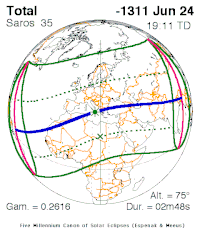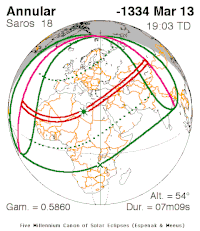Mursili's eclipse




The possible
The reference in the annals was first interpreted as describing an eclipse by
It is now more commonly identified as the one of 24 June 1312 BC, which was visible in
1312 BC eclipse
The 1312 BC eclipse occurred over northern Anatolia in the early afternoon, and its effects would have been quite spectacular for Mursili and his men on campaign:
- 24 June 1312 BC, total eclipse, maximum at 10:44 UTC, 38°12′N 13°42′E / 38.2°N 13.7°E (Sicily)
The 1312 BC date would imply that Mursili began his reign in either 1322 or 1321 BC. This date would be roughly that usually proposed for the death of Tutankhamun. It is known that Šuppiluliuma I was besieging Carchemish when he received a letter from the widow of a Pharaoh (who is called Dakhamunzu in the annals). Šuppiluliuma died shortly thereafter and his successor was Mursili II (whose brother would have been Prince Zannanza sent to Egypt where he died). Thus this appears to be a chronological anchor. However, there are other views, asserting for example that the dead Pharaoh was Akhenaten or that Tutankhamun died later.[6]
1308 BC eclipse
In contrast, the 1308 BC eclipse was annular, and began very early in the morning over
- 13 April 1308 BC, annular eclipse (94.8%), maximum at 04:16 UTC, 44°54′N 85°42′E / 44.9°N 85.7°E (Tian Shan)
See also
References
- ^ KUB XIV 4.24: [ma-a-an I-NA KUR A]zi-ma i-ia-ah-at nu dUTU-us sa-ki-ya-ah-ta "[When] I marched [to the land of A]zzi, the Sungod gave a sign." Theo P. J. Van Den Hout, The Purity of Kingship: An Edition of CTH 569 and Related Hittite Oracle Inquiries of Tutẖaliya (1998), 42f.
- ^ E. Forrer, Forschungen II 1.1 "Astronomische Festlegung des Soppiluljomas, Morsilis und Amenophis IV." (1926) KUB XIV,4 (= CTH 70).
- ^ Astronomische Abhandlungen 8-9 (1929), p. 16. Mitteilungen des Instituts für Orientforschung 6 (1958), 188.
- ^ Bryce (1998)[page needed]
- JSTOR 606505.
- ISSN 1015-5104.
Further reading
- Paul Astrom, 'The Omen of the Sun in the Tenth Year of the Reign of Mursilis II', in Horizons and Styles: Studies in Early Art and Archaeology in Honour of Professor Homer L. Thomas, (1993)
- Trevor R. Bryce, The Kingdom of the Hittites, Clarendon Oxford University Press, (1998)
External links
- Path map (NASA)
